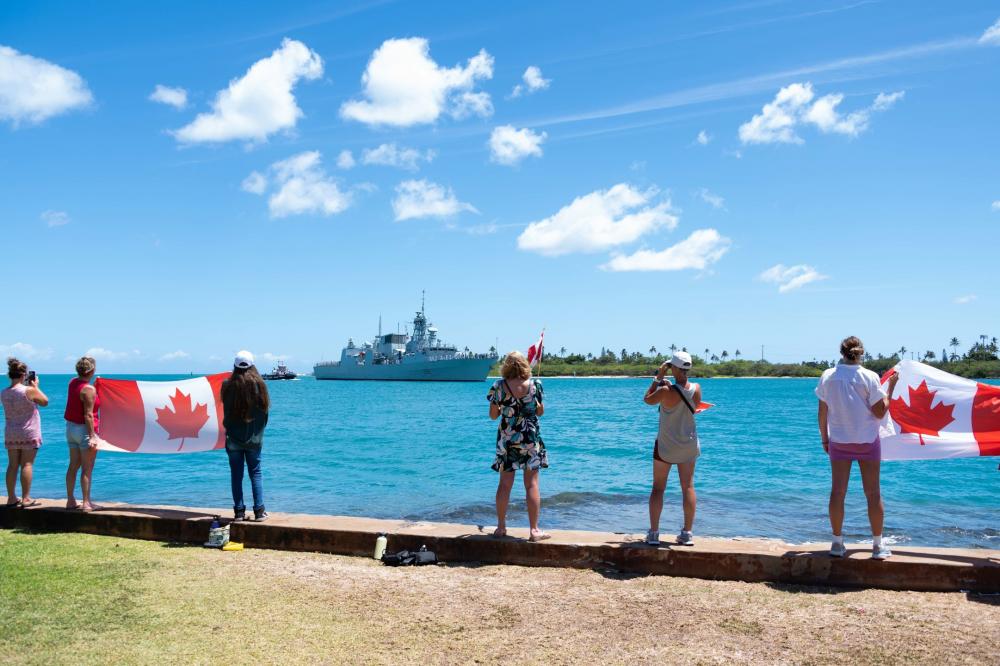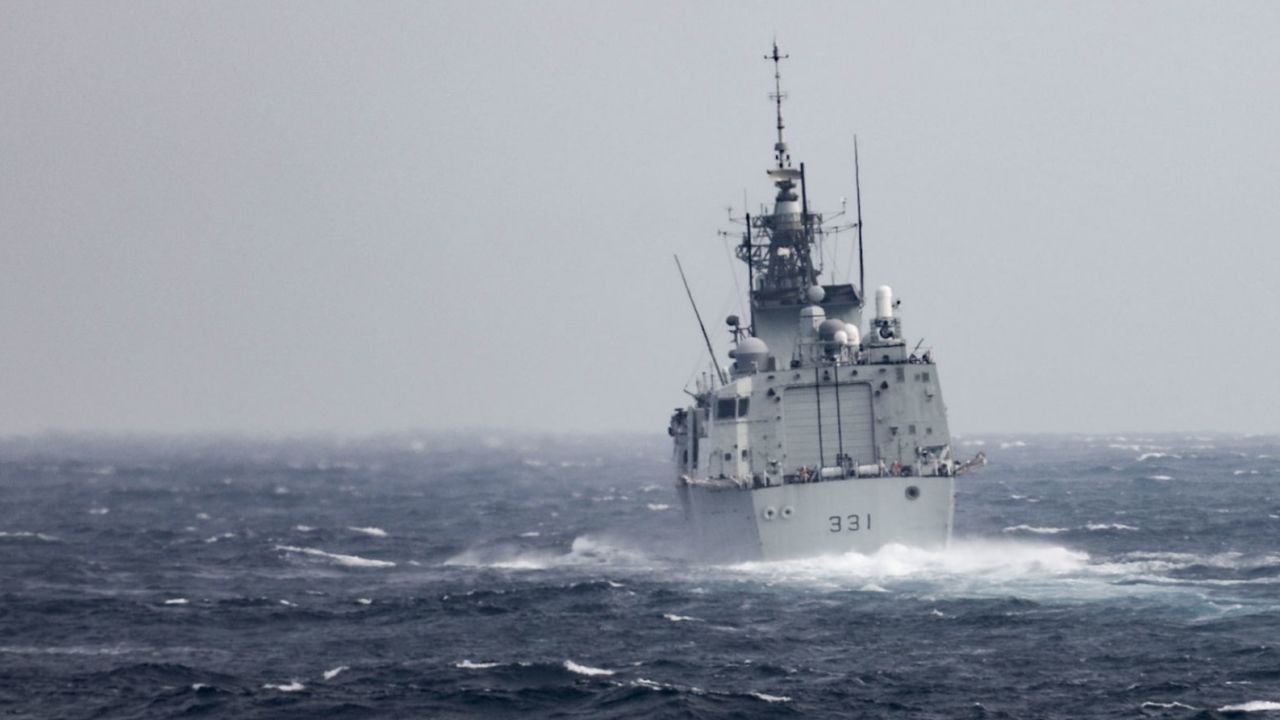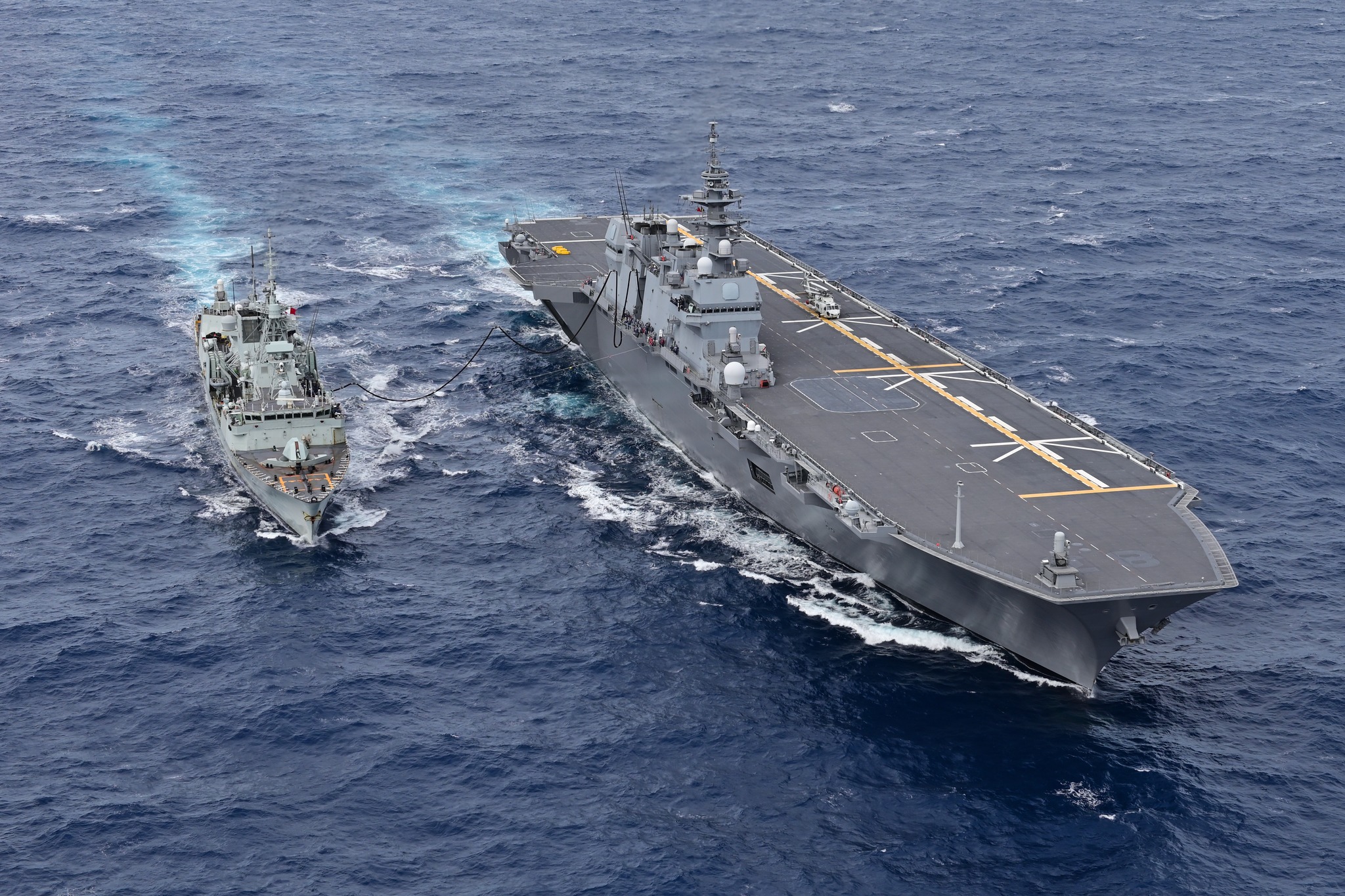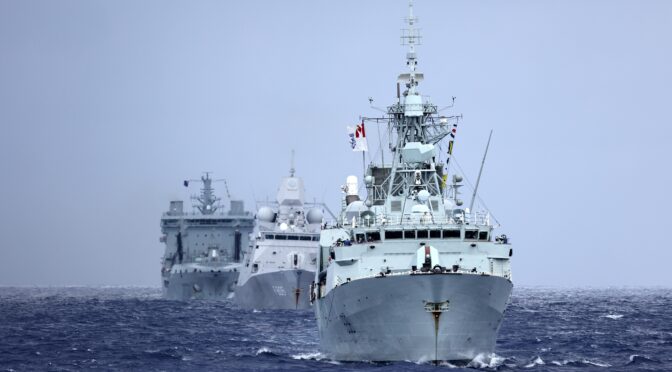By David Scott
Canada has been conducting annual Pacific deployments of strategic import, including Westploy in 2016, Operation Poseidon Cutlass in 2017, and Operation Projection since 2018. These deployments highlight increasing Canadian naval presence and naval exercising with other China-concerned partners in the region. The particularly successful Operation Projection of 2022 has complemented Canada’s recently-released Indo-Pacific Strategy and its maritime provisions for the future.
Canada’s deployments use five Halifax-class frigates based at Maritime Forces Pacific headquartered at Esquimalt, British Columbia. Commissioned in the 1990s and later modernized in the 2010s, these general-purpose warships are mission tailored for anti-submarine warfare. Their deployments schedule is listed below:
- 2016: HMCS Vancouver, August–December
- 2017: HMCS Winnipeg and Ottawa, March–August
- 2018: HMCS Vancouver, April–August
HMCS Calgary, August–December - 2019: HMCS Regina, February–August
HMCS Ottawa, August–December - 2020: HMCS Winnipeg, September–December
- 2021: HMCS Calgary, February–September
- 2022: HMCS Vancouver and HMCS Winnipeg, August–December
In addition, three Victoria-class hunter-killer submarines (HMCSs Victoria, Corner Brook, and Chicoutimi) are also based at Esquimalt. The ships are of 1990’s provenance and not far off end of service, with troubled maintenance issues during the last decade. However, extension of service could be extended into the 2030s under the Victoria-Class Modernization Project. By nature, submarine deployments are secretive, literally below the waves.
Purpose
Westploy’s regional context is identified in the Canadian Navy release in 2016 of Leadmark 2050: Canada in a New Maritime World. The document emphasized the “growing importance of the Indian Ocean,” and presciently stated, “the geopolitics of the Indian Ocean is likely to be exceeded only by the geopolitics of the Asia-Pacific” (p. 6). The document states that Canada needs to “project Canadian power to shape, and when necessary, restore order to the global system” (p. 12) through “a blue water navy, globally deployable and forward postured” (p. 57). Whether such Canadian assets on their own were enough to restore order is a moot question.
The Defence Department announcement for Operation Poseidon Cutlass in 2017 stated, “this near six-month deployment of multiple warships signals the strategic importance of the Indo-Asia Pacific region to Canada and reinforces Canada’s commitment to the maintenance of regional peace and security” in that region. This indicated a shift from previous strategic terminology of the “Asia-Pacific” and brought in India and the Indian Ocean. The result in a general sense sought to “foster friendships, and ultimately trust,” which raises the questions of with whom and about whom?
A key rationale was presence: “importantly, warship deployments such as this also place sea-based capability ‘in-region,’ where it can provide options for the Government of Canada should a timely Canadian response be necessary.” This begs the question of responding to whom? Jeff Hutchinson, Commanding Officer of HMCS Winnipeg was “enthusiastic about the Royal Canadian Navy’s ‘generate forward’ concept” and “the opportunity for HMCSs Winnipeg and Ottawa to strengthen our partnerships with Indo-Asia Pacific nations.” This raised the question of which naval partnerships Canada was strengthening, once again in resonance with the question of with whom and where?
As Canada’s Operation Projection commenced in 2018, the Canadian Defence Department used similar rationales, “these deployments are tangible proof of Canada’s determination to have a persistent maritime presence, and to enhance Canada’s network of defense partnerships in the region.” Tony Williams, the Public Affairs Officer of HMCS Vancouver stated, “the mission will also demonstrate the Canadian Armed Force’s ability to project naval influence.” The rhetoric surrounding the 2022 Operation Projection was pointed. General Wayne Eyre, Chief of Defence Staff announced that the deployment “is a visible display of our continued commitment toward protecting regional security and maintaining a free, open, and inclusive Indo-Pacific.” Anita Anand the Minister of National Defence stressed “the importance of the Indo-Pacific region to global stability and prosperity” whereby “through contributions like Operation Projection and Operation Neon, Canada will continue to work with allies and partners to bolster the rules-based international order in the region.”
Exercises
Pacific deployment patterns demonstrate modest Canadian unilateral outreach but exercising with other powers demonstrates some significant security convergences. Canada has participated in the U.S. led Rim of the Pacific (RIMPAC) biannual exercises ever since they started in 1971. In addition, since 2016, Canada’s frigates participated in various new bilateral, trilateral, and multilateral naval exercise formats, alongside powerful allied contributions, and often with China tacitly in mind.
In the 2016 Westploy operation, having maintained Canadian participation in RIMPAC, HMCS Vancouver initiated participation in Australia’s Kakadu exercise. This included navies from Australia, Fiji, France, India, Indonesia, Japan, Malaysia, New Zealand, Pakistan, Papua New Guinea, Philippines, South Korea, Singapore, Thailand, Timor Leste, Tonga, U.S., and Vietnam. Vancouver activities included replenishment by the Australian tanker HMAS Success.
New exercise networks were added with Operation Poseidon Cutlass in 2017. HMCS Ottawa and HMCS Winnipeg conducted underwater, surface, and air warfare exercises with Australia’s frigate, HMAS Ballarat, in the South China Sea in April. A demonstration of Canada’s first bilateral exercise in these waters, wrought with excessive maritime claims by the People’s Republic of China. En route to Singapore, Ottawa operated with a French frigate, FNS Prairial, in the Malacca Strait. In May, Ottawa led a South Korean destroyer, ROKS Dae Jo Yeong, a Filipino offshore patrol boat, BRP Gregorio Del Pilar, a French frigate, FNS Prairial, and a U.S. destroyer, USS Sterett, in maneuvering and communication drills within the Singapore-organized Weapons Multilateral Sea Exercise (WMSX) in the South China Sea. The Western Pacific Naval Symposium (WPNS) organized this exercise and Canada has been an original member since its inception in 1988.
Next, Ottawa and Winnipeg participated in Pacific Guardian 17 – a new four-way multilateral exercise in the East China Sea in June, alongside a Japanese destroyer, JS Inazuma, a New Zealand frigate, RNZN Te Kaha, and a U.S. cargo ship, USS Wally Schirra. Winnipeg and Ottawa then carried out underwater, surface, air, and electronic warfare defense drills in late June with South Korean destroyers, ROKN Gang Gam Chan and ROKN Yulgok Yi One. Winnipeg and Vancouver also participated in Kaedex (“Maple”) exercises during July of 2022 with Japanese destroyers, JS Umigiri and JS Abukama, in the Sea of Japan. After the Canadian frigates returned to base by August, HMCS Chicoutimi, a submarine, commenced a 197-day deployment from Esquimalt the next month in September via Pearl Harbor and Guam to Yokosuka and Sasebo in Japan – a first time public deployment there.
In 2018, Operation Projection served as the steppingstone for further and more frequent combined exercises. HMCS Vancouver participated in RIMPAC; later in the year HMS Calgary again participated in the previously mentioned Australian-led Kakadu exercise and the Kaedex exercise with Japan. Beyond this, Calgary initiated Operation Neon, which monitored UN sanctions against North Korea in the East China Sea. The Calgary then joined in, for the first time, the Keen Sword exercises involving extended anti-submarine drills with the U.S. and Japan to include: the aircraft carrier, USS Ronald Reagan and Japanese helicopter carrier JS Hyuga.
The 2019 Operation Projection deployment consisted of two phases, carried out by HMCS Regina and then HMCS Ottawa. Both performed Operation Neon duties in the East China Sea, both transited the Taiwan Strait, and both carried out Kaedex exercises with Japan. However, in a new setting, the Regina carried out Kaedex exercises in June with the Japanese Indo-Pacific Deployment group comprised of a helicopter carrier, JS Izumo, accompanied by her two Japanese destroyers, JS Akebono and JS Mursame, by Cam Rahn Bay, Vietnam. Ottawa carried out Kaedex exercise in October with two Japanese destroyers, JS Chokai and JS Shimakaze, off Yokosuka, Japan. In another new development, Regina initiated Canadian participation in the biannual U.S.-Australia Talisman Sabre 19 exercise, held in July off Queensland. She sailed alongside the U.S. Ronald Reagan Carrier Group and Australia’s helicopter dock ship HMAS Canberra.
In turn, Ottawa also initiated Canadian participation in the second Pacific Vanguard exercise off Guam (first held the previous May) in November. The Ottawa sailed alongside Australian, United States, and South Korean ships to include Australian destroyer, HMAS Hobart, Australian frigates, HMAS Parramatta and HMAS Stuart, a submarine, a South Korean destroyer, ROKS Choi Young, and U.S. cruiser, USS Chancellorsville. The Ottawa continued to push Canadian involvement in multinational exercises and initiated Canadian participation in the Japanese-led Annualex 19 exercise, alongside an Australian frigate, HMAS Parramatta, Japanese destroyer, JS Shiranui, and U.S. destroyer, USS Milius in the Philippine Sea.
Despite the scaled back itinerary in 2020 Operation Projection due to Covid, HMCS Winnipeg joined HMCS Regina for the Rimpac exercises. As Regina returned to Esquimalt, Winnipeg deployed further westwards and participated in Operation Keen Sword, alongside the Japanese (Escort Flotillas 1 and 4) and U.S. (Ronald Reagan Carrier Strike Group) navies in October through November near Japan.

The following year the 2021 itinerary, though still affected by Covid restrictions, became more robust and introduced new exercise formats. After carrying out Operation Artemis anti-narcotics operations in the Arabian Sea and visiting the combined UK/US base at Diego Garcia, HMCS Calgary exercised in another trilateral format with a Japanese destroyer, JS Akebono, and Australian frigate, HMAS Anzac, in the East Indian Ocean, off Sumatra in April. Calgary then participated in a bilateral U.S.-Australian exercise, Talisman Sabre, held in Queensland in July. The Calgary participated in air and anti-submarine drills alongside an Australian frigate, HMAS Parramatta, a Japanese destroyer, JS Makinanmin, and a South Korean destroyer, ROKS Wang Geon.
As the Calgary returned to Esquimalt, HMCS Winnipeg took up the baton. Moving westwards, in September, the Winnipeg joined the new format and participated in Pacific Crown 21-3, operating alongside the U.K. (HMS Queen Elizabeth) and Japanese (JS Ise) carrier groups in the Sea of Japan. Again, in another new format, Winnipeg participated in a powerful three-way carrier operation in the Philippine Sea at the start of October. This three-way carrier operation involved the U.S. (USS Ronald Reagan, USS Carl Vinson), Japanese (JS Ise), and U.K. (HMS Queen Elizabeth) carrier groups. A New Zealand frigate, HMNZS Te Kaha, helped escort the combined carrier strike group as well. Winnipeg then sailed through the Taiwan Strait, with U.S. destroyer, USS Dewey, in mid-October. Afterwards in the Philippine Sea in late November, Winnipeg participated in Annualex 21 where she sailed alongside an Australian destroyer, HMAS Brisbane, an Australian frigate, HMAS Warramunga, a German frigate, FGS Bayern, Japanese Escort Flotilla 1, and U.S. Carl Vinson Carrier Group 1.
The recent 2022 Canadian deployment saw further continuity and change. In terms of continuity, HMCS Winnipeg and HMCS Vancouver participated in the RIMPAC exercises off Hawaii. Both vessels also participated in the powerful Keen Sword exercises in Japanese waters, alongside Japanese (20 ships) and the U.S. (10 ships) warships from 10–19 November. Australia (1 ship) and the UK (1 ship) also participated in this exercise as well. Earlier, Vancouver participated in the Pacific Vanguard exercise in the waters off Guam in late-August, alongside the Japanese Indo-Pacific Deployment (IPD) group (helicopter carrier JS Izumo, destroyer JS Takanami, and submarine JS Takashio), South Korean destroyers (ROKN Sejong the Great and ROKN Munmu the Great), Australia frigates (HMAS Sydney and HMAS Perth) and a U.S. destroyer (USS Barry). The Vancouver accompanied another U.S. destroyer, the USS Higgins, through the Taiwan Strait on 20 September.

Regarding further changes, new developments in the 2022 deployment consisted of participation by HMCS Vancouver in the U.S.-led Pacific Dragon 2022 missile defense exercise held off Hawaii from 8–14 August. Ships serving alongside Vancouver included an Australian frigate, HMAS Sydney, Japanese destroyer, JS Haguro, South Korean destroyer, ROKS Serjong the Great, and U.S. destroyers, USS Fitzgerald and USS William P. Lawrence. Vancouver participated in a trilateral exercise, Noble Raven 22, another new trilateral format, in the Philippine Sea from 30 August to 7 September. Ships serving alongside included the U.S. destroyer, USS Higgins, Japanese Indo-Pacific Deployment (IPD) group, Japanese helicopter carrier, JS Izumo, and Japanese destroyer, JS Takanami. Winnipeg and Vancouver participated in further exercises in the Philippine Sea with the U.S. Ronald Reagan Carrier Strike Group, a U.S. amphibious warship, USS New Orleans, and Japanese destroyer, JS Kirisame, at the start of November.
The Canadian ships also participated in other iterative exercises in the South China Sea. Winnipeg participated in the Noble Raven 22-2 in the South China Sea from 23 September 23 to 1 October. Winnipeg participated alongside a U.S. destroyer, USS Higgins, a Japan’s Indo-Pacific Deployment (IPD) group, helicopter carrier, JS Izumo, destroyer JS Takanami and submarine JS Takashio. The Winnipeg conducted a fuel specific replenishment at sea from the helicopter carrier JS Izumo. This event operationalized the Acquisition and Cross-Servicing Agreement (ACSA) signed between Canada and Japan in 2018.
Further bilateral exercises were carried out in the South China Sea by the Vancouver with the U.S. destroyer USS Higgins on 18 September followed by the Winnipeg on October 2. From 4–8 October, HMCS Winnipeg joined Australian destroyer, HMAS Hobart, Australian frigate, HMAS Arunta, Japanese destroyers, JS Suzutsuki and JS Kirisame, and U.S. destroyers USS Milius and USS Higgins in Noble Mist, where ships practiced surface, subsurface and air defense exercising. It marked the first time this Australia-Canada-Japan-U.S. format has exercised together in the South China Sea.

People’s Republic of China Reaction (PRC)
Canadian relations with PRC have deteriorated in recent years. Canada made friendly port calls in 2017 to Shanghai and then in 2018 to Hong Kong. There have been no further ports calls to China since 2019 or afterwards. This change in port deployments reflects the post-2018 deterioration in Canadian-PRC relations catalyzed by the detention of the Huawei executive Meng Wanzhou and immediate counter arrest by the PRC of Michael Spavor and Michael Kovrig in December 2018. However, even without these catalyzing events, PRC-Canadian relations eroded due to larger and less tangible issues to include Canadian human rights criticisms of the PRC policy in Xinjiang and Hong Kong, as well as wider issues and concerns over the demonstrated PRC entanglement in G5 technology.
Canadian participation has grown in naval exercises that Beijing sees as anti-PRC. The PRC criticized the participation of HMCS Winnipeg in Annualex 2021, held in the Philippine Sea in late November, alongside Australian, German, Japanese and U.S. ships. The PRC also denounced Sea Dragon 22 anti-submarine drills around Guam in January 2022, where a Canadian CP-140 maritime patrol aircraft participated. Canadian Foreign Office criticism in July 2021 of “China’s escalatory and destabilizing actions in the East and South China Seas,” was immediately denounced by the Chinese Embassy in Ottawa. The PRC is further irritated by Canada’s increasing deployments into these waters. PRC criticisms over Canadian “provocative acts” by Winnipeg’s transit through the Taiwan Strait alongside U.S. destroyer, USS Dewey, in October 2021 were repeated with Chinese denunciations of another “provocative move.” A year later, HMCS Vancouver transited the Taiwan Strait alongside U.S. destroyer, USS Higgins, in September 2022.
Though Canada has not yet carried out any freedom of navigation operations (FONOPs) in the South China Sea (Taiwan strait transits are geographically confined to the East China Sea), Canadian unilateral and multinational exercises in the South China Sea remain a pressing concern for Beijing. These Canadian activities have increased in frequency and demonstrated by Ottawa’s and Winnipeg’s previous exercises in the South China Sea in 2016 with the Australian navy (HMAS Ballarat); then Regina’s exercises with Japan’s Indo-Pacific Deployment carrier group off Cam Rahn Bay in 2019. Recently in 2022, Vancouver and then Winnipeg separately participated in exercises in the South China Sea with U.S. destroyer, USS Higgins. Winnipeg stayed in these waters to participate in the Noble Raven 22-2 exercise with Japanese and U.S. warships followed by Noble Mist 22 exercise where the Winnipeg sailed alongside warships from Australia, Japan, and the U.S.
India and the Indian Ocean
Although the Canadian Navy now uses “Indo-Pacific” terminology for its operations, Canada has not really expanded its previous Asia-Pacific (i.e., the Pacific and South China Sea) focus into the Indian Ocean. Moreover, whereas active involvement has been seen with French, Australian, Japanese, South Korean, U.K., and U.S. naval forces in various exercise formats, there have been no similar military exercises with India.
In 2017, HMCS Winnipeg’s sojourn into the Indian Ocean consisted of a quick friendly port call over from Port Klang to Sri Lanka and Mumbai with no bilateral exercises followed by a hasty return to the South China Sea. There is coolness in Canada-India relations, in part hampered by Sikh pro-Khalistan currents in Canada. This makes Canada’s invocation of the Indo-Pacific skewed, as it remains focused on the “Pacific” part rather than the “Indo” part. Geography further compounds this political distancing from India and the Indian Ocean. Situated on the far Pacific Rim, India and the Indian Ocean are even further than the South and East China Sea from the Canadian Pacific shores. The “tyranny of distance” is even further complicated for Canadian projection into the Indian Ocean.
For Canada, the western Indian Ocean is more accessible from Canada’s Atlantic than from its Pacific. For example, Mumbai is 11,660 km from Canada’s Atlantic headquarters in Halifax, Nova Scotia but 12,328 km from Canada’s Pacific headquarters at Esquimalt, British Columbia.
Looking forward
On 5 December, Defense Minister Anita Anand welcomed home HMCSs Vancouver and Winnipeg back to Esquimalt. By then, Canada’s Indo-Pacific Strategy (denounced by the PRC Foreign Ministry) promulgated by the government on 27 November robustly criticized China and also identified the need for “increasing the number of frigates deployed on Operation Projection, to protect navigation and overflight rights in the East and South China Seas.” Simultaneously, Anand announced a C$369.4 million package for 2022–2026 “to increase our naval presence in the region”; whereby annually two frigates from Esquimalt would be joined by a third frigate from Halifax, for “boosting our presence, particularly in the Indian Ocean.” A further C$48.7 million was also allocated to increase Canadian military participation in regional exercises and to bolster military cooperation with Indo-Pacific countries.
A modest but increased Canadian naval presence is projected for the Indo-Pacific, but there are some deployment and partnership issues to keep an eye on. With regard to operations, amid rising pressure by China over Taiwan, will Canada carry out its stated aim to maintain and indeed increase its transit operations in the Taiwan Strait? Will Canada move from general exercising with other partners in the South China Sea, to carry out specific Freedom of Navigation Exercises (FONOPs) in the South China Sea around Chinese holdings? With regard to strategic partners, Canada’s strengthening naval cooperation with Australia, Japan, South Korea, and the U.S. is set to continue, but how far can Canada overcome political frictions over the Khalistan issue to develop impactful and meaningful naval cooperation with India? An omission from current Canadian operations and strategy is naval cooperation with France in the Pacific and Indian Ocean. There is no obvious reason why this should not develop in the Indo-Pacific between these two NATO partners, but will it? Canada is clearly seeking a greater role in the Indo-Pacific, and the evolving nature of its operations and partnerships will merit close observation.
Dr. David Scott is an associate member of the Corbett Centre for Maritime Policy Studies. He is a prolific writer on Indo-Pacific maritime geopolitics and can be contacted at davidscott366@outlook.com.
Featured Image: HMCS Winnipeg, along with HNLMS Evertsen and RFA Tidespring, are shown in formation on Sept. 9 during Exercise Pacific Crown. (UK MOD Crown)

